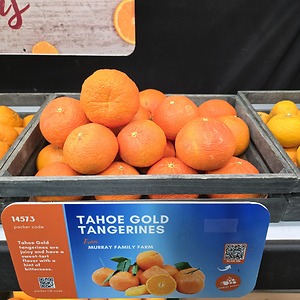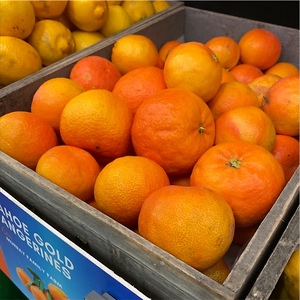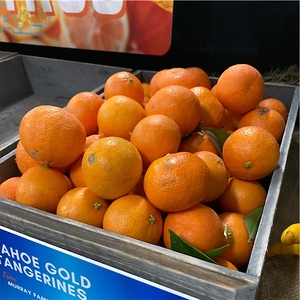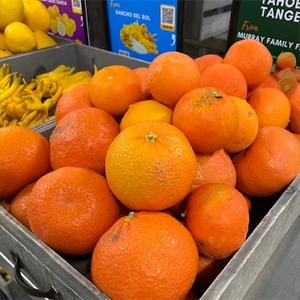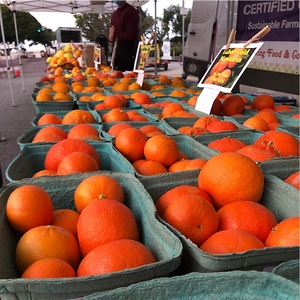


Tahoe Gold Tangerines
Estimated Inventory, lb : 0
Description/Taste
Tahoe Gold tangerines are a medium to large varietal, averaging 5 to 8 centimeters in diameter, and have a round to oblate shape with a flattened top and bottom. Some fruits may exhibit a subtle neck, and the rind typically showcases saturated, dark orange hues. The variety’s rind is also thin and moderately easy to peel. The surface texture of the fruit varies, depending on the tree’s maturity and crop size. Older trees that consistently bear heavy crops are more likely to produce smoother, only slightly pitted rinds with a faintly glossy nature. Lighter crops may bear fruit with a rougher, leathery rind. Underneath the surface, thin membranes divide the orange flesh into 10 to 11 segments. The flesh is aqueous, delicate, fine-textured, and mostly seedless. Tahoe Gold tangerines will feel heavy for their size due to their high juice content. When torn open, the fruits release a light, floral aroma and are edible raw or cooked once ripe. Tahoe Gold tangerines are known for their balanced sugar and acidity levels, creating a sweet, tart, and refreshing flavor with bright, fruity, and floral nuances.
Seasons/Availability
Tahoe Gold tangerines are available in the winter through early spring, with a peak season between mid-January and March in Southern California. Each region's ripening time varies depending on growing conditions and the climate. Tahoe Gold tangerines can appear as early as November in the Northern Hemisphere.
Current Facts
Tahoe Gold tangerines, botanically classified as Citrus reticulata, are a hybrid variety belonging to the Rutaceae family. The mid to late season cultivar was developed in the late 20th century in Southern California and was released as a commercial variety favored for its hardiness, productivity, and flavor. Tahoe Gold tangerines are also commonly known as Tahoe Gold mandarins and TDE3. The variety is a complex mandarin hybrid that ripens in the mid to late season. Tahoe Gold tangerines are larger than other commercial types, mostly seedless, have balanced sugar and acidity levels, and have a deep orange coloring. These qualities, combined with their mid to late-season arrival, allow the fruits to stand out from other commercial mandarins in retail markets. Tahoe Gold tangerines have a refreshing, sweet-tart flavor and are known for their juicy nature. The fruits do not hold well on the tree due to their high juice content. They are seasonally sold in commercial markets as a delicacy and incorporated into various fresh or cooked, sweet or savory culinary preparations.
Nutritional Value
Tahoe Gold has not been extensively studied for its nutritional properties. Mandarins, in general, are a source of vitamins A, C, and E to strengthen the immune system, guard against free radical damage, and maintain healthy organs. Mandarins also provide fiber to regulate the digestive tract and minerals including calcium, phosphorus, potassium, and magnesium. Calcium and phosphorus support bones and teeth while potassium balances fluid levels within the body. Magnesium assists in controlling daily nerve functions, and the fruits also contain other nutrients, including iron, zinc, copper, and manganese. Tahoe Gold tangerines are a source of antioxidants, which help reduce inflammation and contribute to overall bodily health.
Applications
Tahoe Gold tangerines have a refreshing, sweet, and tart flavor suited for raw and cooked preparations. The variety is typically eaten out of hand when ripe and is appreciated for its juicy nature. Tahoe Gold tangerines are also segmented and tossed into green salads or fruit medleys. The fruits add bright notes to garnishes and are sometimes chopped into slaws and salsa. Try serving Tahoe Gold tangerines on fruit plates or pressing the juice into marinades, sauces, glazes, and dressings. The juice can also be incorporated into smoothies, cocktails, and various beverages. In addition to the juice, the rind is popularly zested for subtle bursts of flavor in sweet or savory dishes. Tahoe Gold tangerines are also added to cooked preparations such as stir-fries. Their sweet-tart flavor complements roasted meat like duck, beef, or poultry. Tahoe Gold tangerines can also be simmered into marmalades, jams, and jellies or mixed in as flavoring for baked goods like muffins, scones, and cakes. While less common, the fruits can be added to puddings and custards. Tahoe Gold tangerines pair well with vanilla, maple syrup, chocolate, spices like cinnamon, cloves, and nutmeg, and herbs including mint, parsley, and cilantro. Whole, unopened Tahoe Gold tangerines will keep for a few weeks when stored in a cool, dry, and dark location, like the refrigerator’s crisper drawer.
Ethnic/Cultural Info
Tahoe Gold tangerines are one of the three TDE or Triple Cross Mandarin varieties commercially released from the University of Riverside’s Citrus Breeding Program. The fruit's actual varietal name is TDE3, but the moniker Tahoe Gold was given as a brand name to increase consumer appeal in commercial markets. All three TDE selections were named after major California landmarks, including Lake Tahoe, Mount Shasta, and Yosemite National Park, to celebrate the citrus’ origins in California. Tahoe Gold tangerines are the smallest and earliest maturing of the three varieties and are known to have a deeper rind coloring. The variety is named after Lake Tahoe in Northern California. The freshwater lake spans over twenty-two miles in length and twelve miles in width and is nestled in the mountains along the border of California and Nevada. The name Tahoe is thought to be derived from a mispronunciation of a Washoe word, the native people group that resided at the lake. The Washoe called the lake “Da ow a ga,” roughly translating to “edge of the lake.” Over time, the first part of this word was mispronounced, and the variation Tahoe was developed. Lake Tahoe is one of the clearest lakes in the world, as its high elevation prevents algae from forming. The surrounding soil and rock formations around the lake also act as a natural filtering system, creating the internationally famous clear waters.
Geography/History
Tahoe Gold tangerines are native to California and were developed in the late 20th century through the University of California Riverside Citrus Breeding Program. The variety was created from a complex cross between Encore and Dancy mandarins and Temple tangors. In 1973, pollen from Encore mandarins was applied to the stigmas of a hybrid fruit bred from Temple tangors and Dancy mandarins. Fruits from this cross were collected in 1974, and the seeds were extracted and planted. Triploid seedlings were later chosen from the sprouted planted seeds and were moved to fields in Riverside, California, in 1976. These seedlings were evaluated for many years before one was selected in 1987 and labeled under the varietal name TDE3. Between 1993 and 1996, TDE3 trees were planted at research sites in Ojai, Santa Paula, the Coachella Valley, and Valley Center for further studies, testing, and evaluation. TDE3 was eventually released in 2002 as budwood to growers under the commercial name of Tahoe Gold. The first commercial fruit appeared in markets in 2007. Tahoe Gold tangerines were granted a United States Plant Patent in 2005 under USPP# 15,703, but this patent expired in 2022. Today, Tahoe Gold tangerines are primarily grown in Southern California and are sold through local farmer’s markets and specialty retailers. The variety has also been planted in South Africa and Australia and may be found in select home gardens throughout the United States.








